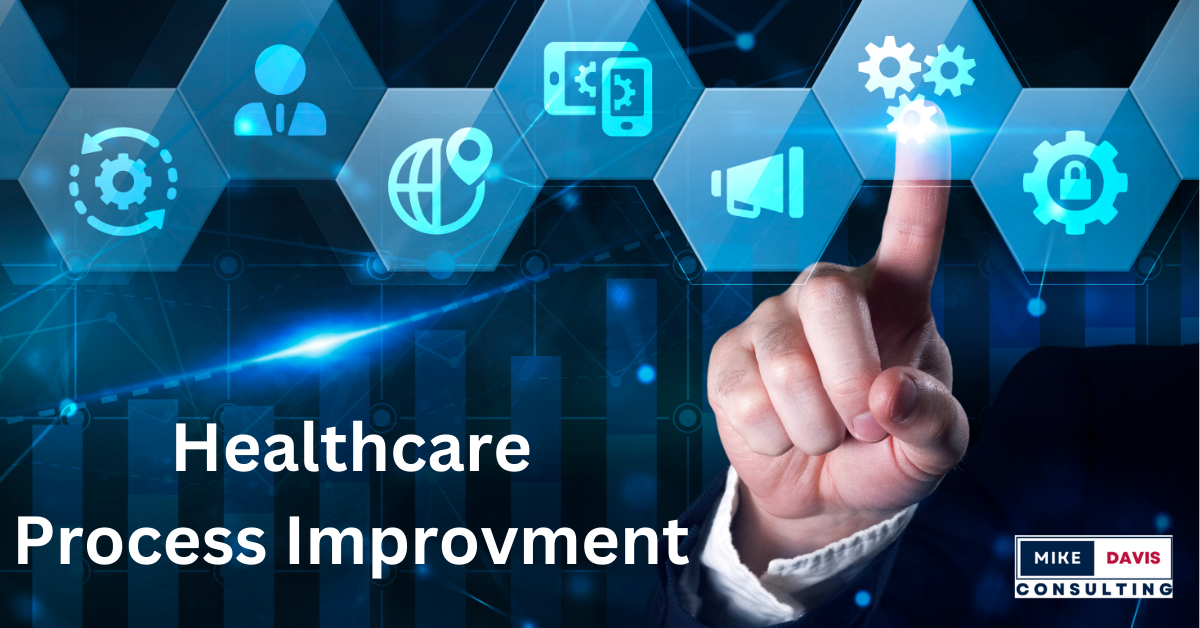Enhanced Healthcare Process Improvement Strategies
In a hospital, every second is crucial. Caregivers rush and machines beep, all in the race to save lives. Efficiency in healthcare processes is vital here. Imagine less crowded emergency departments and patients getting the care they need without delay1.
Imagine a world where every patient interaction is safe. Where the risk of medication errors, threatening seven million people, is gone. This vision can become reality with healthcare process improvement12. Using Lean principles and machine learning can make healthcare smoother. This would prevent waste and make patients and clinicians happier1.
We need to commit to better processes to improve patient outcomes. Imagine reducing harmful drug events by half. This goal is achievable and requires our focus1. Healthcare is balancing tradition and innovation. Embracing new, data-driven strategies can transform care. This will make care more efficient and affordable. It’s a new era for patient-centered care12.
The Importance of Healthcare Process Improvement
In the fast-paced world of healthcare, making patient care better and streamlining operations is vital. Looking closely at what makes healthcare work well shows us that using data to improve processes can make a huge difference. This can lead to better patient care and smoother operations.
The Impact of Optimized Healthcare Processes on Patient Care
Putting money into healthcare systems and having skilled staff can greatly improve how care is given. This leads to better outcomes for patients3. Better communication between health professionals and using a shared information system make sure important details are easy to find.
This helps in providing effective patient care and improving how healthcare works3. Also, using telehealth services has made it easier for people to get the care they need, which has been a big help in improving patient health3
Data-Driven Approach: Key to Advancing Healthcare Operations
A strong focus on data is not just about gathering it, but analyzing it to make healthcare better. With new technology, healthcare teams can use data more effectively. This has led to better quality care for patients4. For example, trying to improve how care is given has made care coordination better and decreased the need for patients to return to the hospital.
This helps in achieving the goal of better outcomes for patients4. Healthcare places that use processes like Business Process Management (BPM) have seen big improvements in how they operate. This helps a lot in making healthcare processes better by using data5
New technologies keep changing healthcare for the better. Staying committed to using data will help in not just reaching but going beyond what’s expected in healthcare today when it comes to care quality and efficiency.
Healthcare Quality Improvement through Data and Analytics
In the fast-changing world of healthcare, using data analytics is key to making things better. This tech makes work smoother and helps improve healthcare. It does this by giving important information. This info helps with making smart choices and managing things well.
Utilizing Analytics for Informed Decision-Making
60% of healthcare bosses now use data analytics in their work6. It’s clear that using data helps make top-level decisions in healthcare. This has led to 42% of them seeing happier patients6. With a lot of data, healthcare workers can spot trends, get ready for what’s coming, and make patient care better.
Driving Healthcare Improvement with Effective Data Management
Switching to electronic health records has made it easier to get to lots of patient info7. Good data management means getting accurate info and making sure it’s easy for everyone in healthcare to understand. This makes healthcare keep getting better. It brings big changes in how healthcare is provided and managed7.
To show the big impact of data analytics in healthcare, look at this table. It shows what healthcare leaders say got better:
| Improvement Area | Percentage of Executives Reporting Improvement |
|---|---|
| Patient Satisfaction | 42%6 |
| Cost Savings | 39%6 |
| Access to Patient Data | Significant (Exact figures not available) |
Data analytics is vital not just for business or saving money. It’s also crucial for making healthcare better. It helps by pointing out what needs work. This leads to a stronger system. A system that keeps improving and focuses on patient care.
Streamlining Healthcare Processes to Increase Efficiency
Making healthcare more efficient is key. It helps not only with saving time but also improves the whole system.
New methods have cut the average stay in hospitals from 11.5 days to 4.4 days8. In the emergency rooms, the wait time fell sharply. It went from nearly 12 hours to just over an hour8. These changes show how vital better healthcare operations are for patient care and using resources wisely.
Also, by using new tech and better processes, hospitals can now use beds faster. The rate went up from 0.57 to 0.938. This means they can care for more people quickly, which is key when lots of people need help.
| Parameter | Before Improvement | After Improvement |
|---|---|---|
| Average Hospital Length of Stay (days) | 11.5 | 4.48 |
| Average ED Boarding Time (hours) | 11.9 | 1.28 |
| Bed Turnover Rate | 0.57 | 0.938 |
Streamlining has also saved lots of money—about $32.8 million8. With these savings, hospitals can further improve and continue making things better.
By adopting these improvements, healthcare providers can not just meet but go beyond patient care standards while staying efficient.
Optimizing Healthcare Workflows with Lean Practices
Lean healthcare practices are key in making healthcare workflows better. They help cut down waste and make care delivery more efficient.
Integrating Lean Methodologies in Clinical Settings
Healthcare is always changing. Here, using lean methods means planning to make things simpler and less wasteful. Using Value Stream Mapping (VSM) lets organizations see and fix processes that slow down patient care9. Lean tools like the 5S method help keep resources organized and ready to use. This makes the workplace better organized9.
9 Also, lean principles make patient care safer and reduce mistakes. They keep the focus on constant improvement for both patients and healthcare workers.
Case Studies: Successful Lean Implementations in Healthcare
Many hospitals have seen big benefits from using lean principles. For example, Lean Six Sigma methods have improved care quality and made operations more efficient9. These methods combine lean ideas with Six Sigma to better quality and lessen process irregularities. This boosts the overall performance of an organization.
Lean leadership is vital in these changes. It ensures efforts to reduce waste and improve workflows lead to real benefits in healthcare facilities9. This kind of leadership is essential to keep up the progress and make lean principles a core part of the organization.
Using lean in healthcare not only makes processes smoother but also greatly benefits patient care. It helps with better patient flow and lowers the chances of patients returning10. These methods have also made staff happier and increased revenue for healthcare groups. This shows the big impact of improving workflows effectively10.
Healthcare Performance Management and Continuous Improvement
Today’s healthcare world stresses the need for healthcare performance management and continuous improvement in healthcare. Challenges and technological changes make high care standards crucial.
Good performance management combines evidence and real data to improve healthcare services. By setting benchmarks in healthcare, these systems navigate complexities. They boost patient care and make operations run smoother.
Setting Benchmarks for Improved Care Delivery
Creating setting benchmarks in healthcare makes goals clear and improves transparency. Organizations can focus on patient safety and care quality1112. Systems-based engineering helps align departments for better outcomes11.
This approach keeps healthcare quality, costs, and safety in check. It makes sure all parts of healthcare delivery are always getting better.
Continuous Monitoring: A Tool for Sustained Performance Enhancement
Continuous monitoring is key to continuous improvement in healthcare. By watching performance closely, organizations can keep improving and face new challenges well. Lean and Six Sigma methods cut down errors and waste, boosting healthcare1113.
Also, data analytics help track improvements. This makes patient care and outcomes better13. It’s important for everyone, from leaders to staff, to work together. This teamwork creates a culture where making things better is normal1213.
Key Strategies for Reducing Emergency Department Overcrowding
Reducing overcrowding in the emergency department is vital for improving patient care and how hospitals operate. Today, hospitals in the U.S. see about 53% of patients admitted for various conditions14. This high number shows how big the challenge is.
The strain on emergency rooms affects how happy patients are. Satisfaction has gone down by 14%14. Also, people are staying in the emergency room for up to 1209 minutes14. This makes it clear we need better ways to handle healthcare.
- Optimization of Workflow and Staffing: To tackle overcrowding, it helps to make workflows better and have the right number of staff. This can cut down wait times. Doctors getting too tired increases wait times by 7%14.
- Predictive Simulation Models: Using math to predict issues is a key method. A big study looked at 19 important articles15 to show this.
- Root Cause Analysis: It’s important to find the main problems before picking a solution16. Learning from what worked in other hospitals is also helpful16.
Leadership plays a big role in handling emergency care. Good leadership helps improve how fast patients are seen. Planning ahead means hospitals can avoid making big changes later. This saves time and resources16.
These strategies help manage emergency room overcrowding and focus on care that puts patients first. By doing this, hospitals can give better care without spending more.
Implementing Predictive Modeling to Improve Patient Flow
Using predictive modeling in healthcare changes how we handle patient care. It uses data to make patient care smoother. This improves patient flow and makes everyone happier.
Leveraging Technology for Smoother Patient Transitions
Using Artificial Intelligence effectively is a game-changer in predicting hospital needs17. Computer programs can examine tons of data. They help us prevent problems and use resources better17.
Enhancing Patient and Clinician Satisfaction with Improved Flow
Introducing technology improves care and cuts down on waiting17. Doctors work better, which lowers stress and makes them happier. This leads to a better atmosphere at work17.
Machine learning advances patient testing and treatment18. Prediction helps manage diagnostic times and patient numbers. This keeps hospitals running smoothly without getting too busy17.
| Technology Applied | Impact on Patient Flow | Clinical Area |
|---|---|---|
| AI Diagnostics | Reduces diagnostic time | Radiology |
| ML-Based Predictive Models | Forecasts patient admission rates | Admissions |
| Real-time Data Analytics | Optimizes bed allocation | Emergency Care |
These tech strategies help hospitals meet today’s needs and tomorrow’s challenges. It shows why predictive modeling is key in healthcare for long-term success19.

“Healthcare Process Improvement” for Medication Error Prevention
Improving healthcare processes is key, especially in preventing medication errors. This enhances healthcare quality and safety. By using better monitoring techniques and changing how drugs are delivered, we can reduce drug-related problems.
Surveillance and Monitoring Techniques for Safer Medication Administration
Using strong surveillance and monitoring is critical. It helps stop medication mistakes and keeps patients safe. Experts believe that thinking systematically and visually can make healthcare safer20.
A study from Spain showed medical errors are a major problem. They cause many deaths. This shows we need good surveillance in healthcareadverse drug event reduction21.
Transforming Drug Delivery Systems to Minimize Adverse Drug Events
Changing how drugs are delivered is important. By organizing pharmacies better and using FIFO systems, finding medicines gets easier and mistakes are less likely. Making these changes helps pharmacy workers be less stressed20.
Studies show that regular checks and feedback in pharmacies can cut down on errors. Making improvements regularly and following standard procedures help prevent mistakes20.
Analyzing data helps understand and prevent medication errors. By studying patterns and using statistical models, we can find better ways to stop errorshealthcare process improvement22.
In short, using better monitoring and changing how drugs are given are key steps. These efforts protect patients and help healthcare save money. By following these innovative ideas, we can make a big difference in healthcare quality.
Addressing Variation in Healthcare Processes
Making healthcare predictable and consistent is key. By making healthcare more uniform and cutting down on differences, patient outcomes can improve vastly.
Standardizing Clinical Processes for Outcome Consistency
Clinical settings need stable and effective processes to ensure top quality patient care. Health managers use things like control charts to keep variation low23. They aim for every patient to get the same high-quality care, regardless of when or where.
Also, using strategies such as Plan-Do-Study-Act (PDSA) cycles helps keep improving23. This way, healthcare keeps getting better, aiming for the best patient outcomes.
Strategies for Reducing Unwanted Variation in Care Delivery
Healthcare leaders use tools to focus on patients who need the most care24. They also use data to follow medical guidelines better, raising protocol adherence significantly23.
Fixing system-wide issues is crucial to lower healthcare variation25. It’s about fixing what doesn’t work well and making sure everyone follows the protocols.
Efforts to make healthcare processes uniform show a deep commitment to improving healthcare quality. It’s all about ensuring reliable, high-quality care for everyone. Providers strive for better clinical outcomes and higher patient satisfaction through these methods.
Fostering Healthcare Innovation with Advanced Analytics Tools
In healthcare today, the use of advanced analytics is key. These tools help turn a lot of complex data into useful information. This information is critical for better patient care and more efficient operations2627.
About 80% of healthcare data is unstructured26. This makes advanced analytics very important. They organize the data and reduce billing errors that cost a lot each year26. These analytics also help healthcare providers make better decisions quickly. This means they can give the right care to each patient.
AI and machine learning help check medical claims very fast26. Kaiser Permanente used AI to save lives and work more efficiently27.
It’s vital for tech, healthcare providers, and payers to work together. This teamwork makes healthcare more tech-focused and efficient26k. Using digital tools that are easy to use and secure is also key for a better healthcare system28.
| Feature | Impact | Statistical Data Source |
|---|---|---|
| Real-time Data Analysis | Enhances predictive healthcare modeling and patient-specific treatment plans. | Advanced analytics tools26 |
| AI in Billing | Reduces errors and administrative costs dramatically. | AI technology effectiveness26 |
| Data Security | Ensures patient data integrity and compliance with laws like HIPAA and GDPR28. | Regulatory compliance importance28 |
As technology grows, healthcare must keep up by adopting these tools. This move ensures top-notch care and keeps them ahead. It creates a strong base for the future of healthcare.
Revising Healthcare Policies for Better Outcomes
The healthcare world is always changing. This means policies must be updated to keep up with new rules and improve patient care and clinic operations. Making these updates helps healthcare providers stay on top of new developments and keep their service standards high.
Evaluating and Updating Healthcare Regulation Compliance
It is crucial to follow healthcare rules closely to reduce risks and better patient care. Governance structures help manage risks by looking at and reducing possible problems29. When we update policies with these evaluations in mind, healthcare places become stronger. By matching up with quality measures approved by AHRQ (check it here)30, facilities can meet the best standards.
Policy Impact on Clinical Workflow and Patient Experience
Updating healthcare policies does a lot. It shapes how clinics operate and deeply affects how patients feel about their care. By improving patient experiences and putting patients first31, healthcare systems can get better results. The way management allocates resources is key in this29.
Also, constantly making healthcare processes better is crucial. Methods like the PDSA cycle and lean are important for keeping healthcare services effective and up-to-date31.
We revise healthcare policies with two goals in mind. First, we must meet today’s standards. Second, we should plan for the future needs of healthcare operations. This process means thinking about more than just meeting rules today. We aim for long-lasting improvement and a continuous move towards greatness and ready change.

Conclusion
In the world of medicine today, making healthcare better is a big goal. We’ve looked at many approaches, like using data analytics and Lean practices. These methods help make healthcare work smoother and improve the quality of care. It’s clear that having care that’s tailored to each person and quick access to medical records32 is critical for good patient care. Many patients and doctors agree on this point.
These approaches also tackle tough problems outside of the clinic, like making sure seniors and those with disabilities have good housing, as the law requires33. At the same time, efforts to create a culture of continuous improvement in healthcare facilities lead to better care. Building such a culture needs strong leaders and openness to change34. This work pays off with the trust and happiness of the people we care for.
Finally, we see that there isn’t just one way to coordinate care. But, by focusing on the patient and keeping in mind laws and housing needs, we can make big changes in healthcare. Looking ahead, healthcare systems need to stay flexible and keep improving. This way, they can meet the needs of patients and workers. New opportunities for innovation and excellence are out there, waiting for us.
FAQ
What is healthcare process improvement?
How does optimized healthcare processing impact patient care?
Why is a data-driven approach crucial in advancing healthcare operations?
What role do analytics play in healthcare quality improvement?
How can streamlining healthcare processes increase efficiency?
What are lean healthcare practices and how do they optimize healthcare workflows?
How is continuous improvement integrated into healthcare performance management?
What strategies are effective for reducing emergency department overcrowding?
How does predictive modeling contribute to improving patient flow?
In what ways can healthcare process improvement prevent medication errors?
How does addressing variation in healthcare processes lead to better outcomes?
What is the link between healthcare innovation and advanced analytics tools?
Why is it essential to regularly revise healthcare policies?
Source Links
- https://www.healthcatalyst.com/insights/healthcare-process-improvement-6-strategies – Healthcare Process Improvement: 6 Strategies
- https://scribehow.com/library/healthcare-process-improvement – Healthcare Process Improvement: Enhancing Patient Outcomes, Reducing Costs & More | Scribe
- https://document360.com/blog/healthcare-process-improvement/ – How Healthcare Process Improvement Transforms Patient Experience
- https://www.snhu.edu/about-us/newsroom/health/what-is-quality-improvement-in-healthcare – What is Quality Improvement in Healthcare?
- https://www.ncbi.nlm.nih.gov/pmc/articles/PMC10081584/ – Process-based Management aimed at improving health care and financial results
- https://healthadministrationdegree.usc.edu/blog/how-health-care-data-analytics-improves-quality-care – How Health Care Data Analytics Improves Quality of Care | USC EMHA
- https://pubmed.ncbi.nlm.nih.gov/35578818/ – Using data analytics to enhance quality improvement projects – PubMed
- https://www.ncbi.nlm.nih.gov/pmc/articles/PMC10910643/ – Streamlining patient flow and enhancing operational efficiency through case management implementation
- https://www.6sigma.us/lean-six-sigma-articles/lean-principles-in-healthcare/ – Lean Principles in Healthcare driving Patient-Centric Excellence – SixSigma.us
- https://dhinsights.org/blog/how-workflow-design-can-improve-healthcare-delivery/ – How workflow design can improve healthcare delivery
- https://www.ncbi.nlm.nih.gov/books/NBK316143/ – Systems Strategies for Continuous Improvement – Transforming Health Care Scheduling and Access
- https://www.msicertified.com/blog/continuous-improvement-in-healthcare/ – Continuous Improvement in Healthcare
- https://www.twi-institute.com/continuous-improvement-healthcare/ – Continuous Improvement In Healthcare
- https://www.ncbi.nlm.nih.gov/pmc/articles/PMC10890971/ – Strategies to Measure and Improve Emergency Department Performance: A Review
- https://www.ncbi.nlm.nih.gov/pmc/articles/PMC9961148/ – Main Features and Control Strategies to Reduce Overcrowding in Emergency Departments: A Systematic Review of the Literature
- https://www.ahrq.gov/sites/default/files/publications/files/ptflowguide.pdf – Improving Patient Flow and Reducing Emergency Department Crowding: A Guide for Hospitals
- https://www.factspan.com/blogs/harnessing-the-power-of-artificial-intelligence-to-improve-patient-flow-in-hospitals/ – Predictive data modeling for patient flow optimization in hospitals | Factspan
- https://www.ncbi.nlm.nih.gov/pmc/articles/PMC10517477/ – Revolutionizing healthcare: the role of artificial intelligence in clinical practice
- https://www.ncbi.nlm.nih.gov/pmc/articles/PMC7710328/ – Clinical Implementation of Predictive Models Embedded within Electronic Health Record Systems: A Systematic Review
- https://nmcdn.io/e186d21f8c7946a19faed23c3da2f0da/04f896f61e0b45afb7c86b653ef4a60a/files/publications/IERC_2010_Gebicki_et_al.pdf – Hospitals are complex systems of nurses, doctors, pharmacists, support staff, and patients in which medication errors are common
- https://www.ncbi.nlm.nih.gov/pmc/articles/PMC7432005/ – Applying Lean in Process Innovation in Healthcare: The Case of Hip Fracture
- https://scholarworks.montana.edu/server/api/core/bitstreams/464b0116-1d26-4764-aadc-28846acd1422/content – 1
- https://www.ncbi.nlm.nih.gov/pmc/articles/PMC3066789/ – The meaning of variation to healthcare managers, clinical and health-services researchers, and individual patients
- https://www.healthcatalyst.com/insights/reducing-variation-in-healthcare-to-boost-improvement – Reducing Variation in Healthcare to Boost Improvement
- https://evidence.care/reduce-variation-in-healthcare/ – Reduce Variation in Healthcare | Steps to get started
- https://www.healthcareittoday.com/2024/06/21/fostering-innovation-in-care-delivery-payment-models-and-patient-engagement-with-collaborations/ – Fostering Innovation in Care Delivery, Payment Models, and Patient Engagement with Collaborations | Healthcare IT Today
- https://about.kaiserpermanente.org/news/fostering-responsible-ai-in-health-care – Fostering Responsible AI in Health Care
- https://www.linkedin.com/pulse/comprehensive-strategies-successful-healthcare-dr-manish-shrivastava-pjktc?trk=public_post – Comprehensive Strategies for Successful Healthcare Digital Transformation
- https://www.ncbi.nlm.nih.gov/pmc/articles/PMC10676194/ – Improving Patient Outcomes Through Effective Hospital Administration: A Comprehensive Review
- https://www.ncbi.nlm.nih.gov/books/NBK2682/ – Tools and Strategies for Quality Improvement and Patient Safety – Patient Safety and Quality
- https://www.symplr.com/blog/healthcare-process-improvement-to-enhance-leadership-decision-making – Use Healthcare Process Improvement to Enhance Leadership Decision Making | symplr
- https://www.ncbi.nlm.nih.gov/books/NBK44009/ – Conclusions – Closing the Quality Gap: A Critical Analysis of Quality Improvement Strategies (Vol. 7: Care Coordination)
- https://nap.nationalacademies.org/read/13149/chapter/9 – 7 Conclusions and Recommendations | Health Care Comes Home: The Human Factors
- https://kpmg.com/xx/en/home/insights/2019/01/continuous-quality-improvement-in-health.html – Continuous improvement in healthcare





